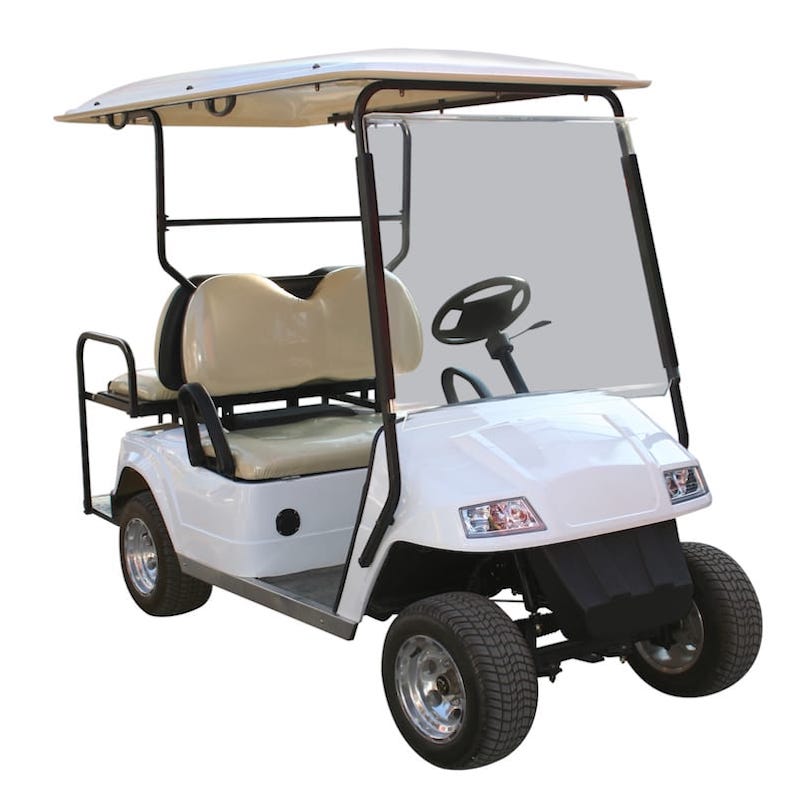Being fuel-efficient is great and all, but sometimes getting from point A to point B is hard enough as it is. Let’s face it, London traffic is the worst. That’s not even an exaggeration. According to data from INRIX, it’s the most gridlocked city on the planet, more congested than Paris, Brussels, Moscow, and Rome.
So, driving in this nightmarish traffic is already a feat. Let’s face it, you’re either stopped completely or inching your way along at a snail’s pace. And if you’re trying to be fuel-efficient, you might think it’s a lost cause altogether. But, fuel-efficiency is actually a thing in urban environments. Yes, even London.
And contrary to popular belief, you don’t have to speed to your destination to get there faster and save on fuel. In fact, you might be better off driving a golf cart on the streets of London if getting places quickly is important to you.

Sadly, you’re not legally allowed to drive a golf cart on public roads, but it’s still pretty cray. And again, we’re not even exaggerating. It’s the actual truth!
Out-dated data that’s become lore suggests that the most fuel-efficient driving speed is 56 miles per hour. But it seems like that’s not necessarily true, especially in urban environments which are densely populated and involve constantly having to slow down and speed up again. So what is the best speed?
The team behind Future Transport recently carried out comprehensive simulations into urban environments like London to establish the most fuel-efficient driving speed in cities. And the results were pretty surprising.
Here’s how the experiment worked
In their latest simulation, the team tested the effects of different acceleration rates and maximum speeds in London-style stop-start traffic.
Their goal was to see what the effects of accelerating to the maximum legal speed in London-style traffic would be, as well as what impact driving style and vehicle size and type have on fuel consumption.
The model was based on Google Street maps of large London roads and on driving around London in different traffic conditions during different times of the day. The average number of obstructions per mile was set at 7, with a 70% chance of an obstruction that resulted in the driver having to stop.

This resulted in an average speed of around 7.5mph, which is about right for cities like London.
They also modelled different aspects of driving style, such as acceleration and engine speeds at which drivers change gears, but kept some variables the same for simplicity’s sake. This would not be the case in reality, of course, but the model was pretty accurate as far as these things go.
The simulation, involving 100 cars, was repeated 50 times to draw some interesting conclusions about fuel efficiency in the city.
What is fuel efficiency?
Fuel efficiency is like being a savings ninja cum professional driver. It’s all about how to maximise mileage with fuel. Basically, it’s using as little fuel as possible to go as far as possible. And saving some cash in the process.
All sorts of factors are used to work out fuel efficiency, from your driving style to the size of your car, to the speed at which you drive.
A fuel efficient-car also pollutes less. You travel further with less fuel. This means less carbon dioxide and harmful gases are released into the atmosphere.
It’s a win-win situation; you save your much-needed cash and you help the planet out a little.
Higher speeds aren’t always more fuel-efficient
Historically, it’s been widely viewed that speeds of 56mph are the most fuel-efficient. But the simulations carried out by the team at Future Transport found this to be largely untrue. This is because the higher speed figure does not take into account the impact of accelerating and decelerating.
And let’s face it – if you’re travelling in an urban environment, you will likely need to brake for various hazards and obstructions multiple times. Just think of all the traffic lights! Now, add a couple of cyclists who you can’t overtake safely, children running into the road, and others braking suddenly in front of you, or even just reversing from their driveways.
All of these situations call for decelerating, braking, or even coming to a full stop. And they’re not all that uncommon in urban environments.
Simulations run by Future Transport that took these constant obstructions into account found that the most fuel-efficient speed is much lower than we originally thought. In fact, it’s often significantly lower than the posted speed limit in cities.
Higher speeds won’t get you to your destination (much) faster
In today’s world, we’re always looking for ways to save time and fuel. It seems like we’re always in a hurry to get somewhere. But did you know that your driving speed isn’t always directly proportional to how fast you’re going to reach your destination? In other words, just because you drive faster, doesn’t mean you’ll get there faster.
In fact, the simulations showed that there is little improvement in travel time and average speed when the speed limit increases above 30mph. Yup, the average travel speed in urban environments increased by just 2.7% when driving at 40mph as opposed to 30mph.
This is a much smaller increase when compared to the average travel speed increase between 20mph and 30mph. People travelling at 30mph are likely to see a 12.9% increase in average speed over people travelling at 20mph.
The point is, going faster is not always better. It won’t always make a staggering difference to your travel time.
This is the most important factor affecting the average journey time
“But if speed isn’t directly proportional to my journey time, then what is?”, we hear you wondering.
It turns out that the most important factor when it comes to predicting the average journey time is actually the number of cars that pass through each green light cycle. And this is primarily affected by the gap between cars as well as their size.

The bigger the vehicles, the fewer of them get through each green light. The fewer of them that get through, the slower the average speed.
In fact, Future Transport said that if everyone in London opted to drive a golf buggy with a top speed of just 15mph, average speed would still increase to around 8.9mph. This reflects an improvement in journey times of over 20% as compared to full-size cars doing 30mph where the average speed would be just 7.4mph.
That’s right, golf carts going at half the speed of full-size cars would get you to your destination faster. Don’t believe us? Check out Future Transport’s video simulation here.
This is the most fuel-efficient driving speed
We all want to get to our destination as quickly and efficiently as possible. And if we can save some money along the way, all the better! But it turns out, going as fast as you can in cities isn’t necessarily the most fuel-efficient option. And it won’t necessarily get you to your destination as fast as you think.
If fuel efficiency is your concern, sticking to 20mph is probably your best bet in cities. This will not only save you money on your fuel, but it’s also slightly better for the planet.
Side note and shameless plug: If you care about the planet, make sure to check out our temporary car insurance policy which includes the free optional add-on Zixty Miles where we offset your carbon dioxide emissions when you drive and plant trees on your behalf too.
And if getting to your destination fast is the main issue, then 30mph (where the speed limits allows) is probably your best bet. Any faster and you’ll only see a negligible improvement in journey times.
Yup, things are never as simple as just going as fast as you can like you’re an extra on Fast and Furious.
Conclusion
Given that speed is hardly the most important factor when it comes to average journey times, it makes even more sense to drive at the most fuel-efficient driving speed even if it’s slower.
What’s the point of wasting fuel and releasing needless CO2 into the atmosphere, when you won’t even necessarily get to your destination much faster?
So what is the most fuel-efficient driving speed in cities?
It is… *drumroll* … 20 miles per hour!
Shocked? We were.
There’s a caveat there, of course. Going over 20 mph can be more efficient — but only if you can keep up the pace without much deceleration or acceleration for at least 0.5 km (0.3 miles) at a time.
If you’re too frequently slowing down and speeding back up, then 20 mph is still likely your best bet. And, spoiler alert, when driving in urban environments, it’s highly unlikely you’ll go 0.3 miles without having to slow down for someone or something.
Also, that 0.3 mile thing only applies to smaller cars like a Ford Focus. If you’re driving a fancy SUV, the distance you’d need to go without stopping to make speeds higher than 20mph efficient jumps to 1.2km (0.7 miles). That’s even more impossible in an urban environment.
Moral of the story? Cruise at 20 mph like no one’s watching – but you might not be popular doing it! That is – if you care about being fuel efficient (we know that golf carts aren’t allowed on the road, and if they were, you might get nicked for obstructing other road users. Boo…)